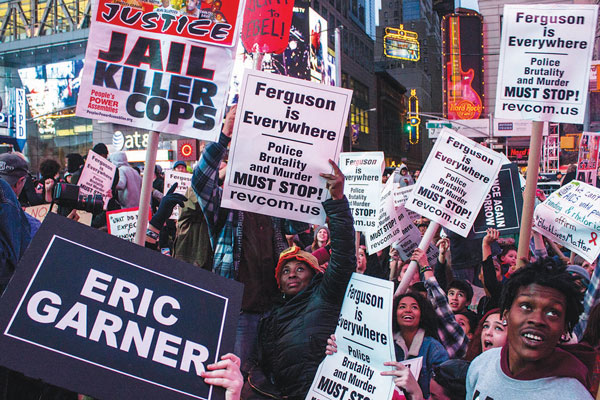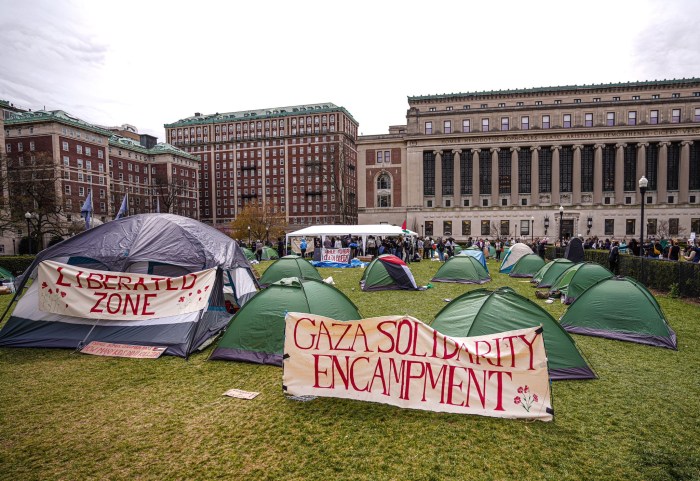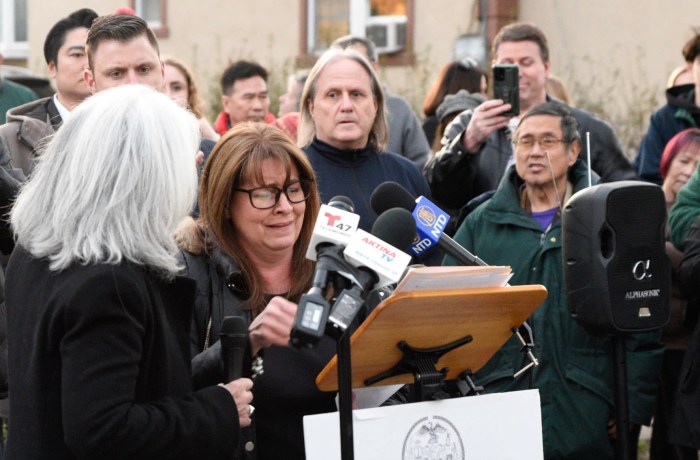
BY ZACH WILLIAMS | High school students led the way through Midtown on Monday as about 1,000 people marched in protest against police brutality.
They gathered at Union Square before marching along a meandering path to Times Square where they sat in silence to honor Michael Brown, the 18-year-old from Ferguson, Missouri, fatally shot on Aug. 9 by former Police Officer Darren Wilson. The Nov. 24 decision by a grand jury not to indict Wilson catalyzed protests across the country, including in New York City.
Following the announcement, thousands of New Yorkers took to the streets that night in Midtown and Downtown Brooklyn, blocking East River bridges and traffic. Actions continued throughout the week, including on Black Friday when demonstrators swarmed Macy’s at Herald Square. Wilson resigned from the Ferguson Police Department on Nov. 29.
Police officers who shoot people of color face too few consequences, protesters say. Investigations continue in some cases, though, including the death of Eric Garner, a Staten Island man who died while being arrested by New York police officers, one of whom used an illegal chokehold on him.
“We need justice in America. It’s false advertising what we have here,” said Mia Luna, a student at New York Harbor School on Governors Island who, like many participants, said she learned of the march through social media.
Police mistreatment of minorities should coalesce into a national movement against racism, activists said, adding that protests must continue for that to happen. A handful of local teenagers did their part by organizing through last weekend to make sure that New York City would not be left behind.
But before they could take the streets on Mon., Dec. 1, some students had to overcome the resistance of school administrators reluctant to let them participate in political action at the expense of their studies.
The problem was particularly acute at New York Harbor School because the waters of New York Harbor also stood in their way. According to student-organizer Shana Buckstad, 167 students at the school congregated at the island’s ferry terminal at about noon, but they were given seats onboard only after a half-hour sit-in.
“We sat there on the ground with our hands up and said, ‘Hands up! Don’t shoot!’ and then we were ready and we got on the ferry,” said Buckstad.
Students came to the Midtown march in large numbers from four other schools, according to student organizer Mojique Tyler, who attends Bard High School Early College, at 525 East Houston St. Representatives of a dozen more schools were also present, he added.
Students networked last week following the grand jury announcement in the Wilson case, according to Buckstad. After meeting on Nov. 28 with representatives of the Ferguson Action Team — a coalition of activists organizing protests in 70 cities —the student activists said they had found their way to get New York City students more involved as students nationwide prepared to walk out of classes on Dec. 1
“The young people are leading like they were leading in the Sixties, and I came out to support them and say, ‘Let’s do it together,’ ” said Geoffrey Davis. His brother, James Davis, was a city councilmember who was gunned down in City Hall by a political rival in 2003.
The action team and other activist groups provided the signs, which included slogans borrowed from activists in Ferguson. Tyler created a Facebook group from which word spread. Hundreds of students responded — a greater than anticipated number, he said.
Adults would also join the march, by the time it got moving at about 1:15 p.m., comprising an estimated two-fifths of the total turnout.
Activists first circled Union Square, moving through the square’s seasonal Holiday Market in the process. They then headed east on E. 15th St. before turning north on Third Ave. Over the next two hours, they zigzagged their way toward Times Square, all the while highlighting what they charged is the disparity between police treatment of white people and communities of color.
Annmarie Jackson of Canarsie, Brooklyn, said her teenage son is regularly harassed by police, sometimes twice per day.
“Police treat us like we don’t matter, and for what it’s worth we do matter,” she said.
Confrontation between cops and activists was minimal on Dec. 1, but the former kept a tight watch over the marchers, threatening to arrest those who ventured into the street from the sidewalk. At certain points, activists attempted to swarm streets, only to retreat as police steered them back onto the pavement with scooters and stern warnings.
About a half-dozen protesters were arrested over all, said an observing attorney for the National Lawyers Guild. It wasn’t clear if a cyclist arrested at Eighth Ave. and W. 48 St. was actively participating in the march.
Arriving in front of the New York Police Department stationhouse in Times Square, activists gathered for four-and-a-half minutes of silence in recognition of the four-and-a-half hours that Brown’s body remained on the street following the Aug. 9 shooting. But they were not done following the die-in — or the rabblerousing oratory. They took off once again at about 3:30 p.m. heading further into Hell’s Kitchen.
They tried once more to escape the police detail, briefly flooding onto Eighth Ave. near W. 45 St. Police quickly regained their position as the march turned toward the Hudson River at W. 48th St.
A half-dozen students at Professional Performing Arts High School cheered the marchers on as they passed by.
By 4 p.m. they were back at Times Square, though their numbers had decreased to about 300. Some passersby paid little attention to the demonstration, but others expressed delight.
Mike Simmons, who works in the tourism industry, said fear of the N.Y.P.D. discouraged him from civil protest after police officers entered his home in October without reason, according to him. Police treatment of minorities requires personal experience to fully comprehend, he said, but people need to unite against it nonetheless.
“You understand it,” he said, “but when it happens to you, it’s mind-boggling.”

















